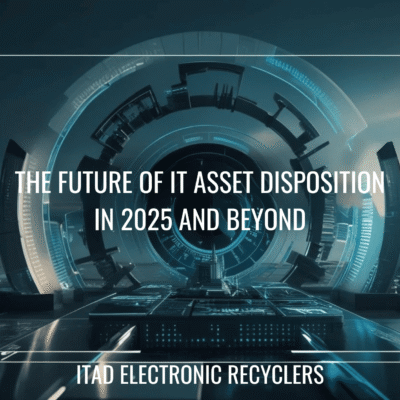Introduction
Sustainability has become a core priority for businesses worldwide. With growing pressure from regulators, investors, and consumers, companies are expected to adopt eco-friendly practices that reduce waste and minimize environmental impact. However, one area often overlooked in corporate sustainability efforts is IT asset disposition (ITAD).
Electronic waste (e-waste) is one of the fastest-growing waste streams globally, with businesses generating millions of tons of retired IT equipment every year. Without a proper disposal strategy, outdated computers, servers, and mobile devices contribute to landfill pollution, resource depletion, and hazardous waste contamination. A structured ITAD process ensures that businesses can reduce e-waste, recover valuable materials, and contribute to a circular economy, all while meeting sustainability and Environmental, Social, and Governance (ESG) goals.
📌 Related: The Role of E-Waste Recycling in a Circular Economy
The Environmental Impact of IT Waste
As technology advances, businesses continuously upgrade their IT assets, replacing old hardware with newer models. While necessary for productivity, this rapid turnover has led to a major increase in IT waste.
E-waste contains hazardous materials such as lead, mercury, and cadmium, which can contaminate soil and water supplies when disposed of improperly. Additionally, IT equipment requires significant amounts of rare earth metals and precious resources to manufacture. Without effective recycling programs, these non-renewable materials are lost, leading to greater environmental harm and increased mining demand.
By implementing an ITAD strategy focused on sustainability, businesses can:
- Reduce landfill waste by extending the lifecycle of IT equipment.
- Recover valuable materials such as gold, silver, and copper for reuse.
- Lower carbon emissions by decreasing the need for new raw material extraction.
- Comply with environmental regulations that mandate responsible disposal.
📌 link: EPA Electronics Recycling Guidelines
How ITAD Contributes to Green IT and Sustainability
A well-managed ITAD program aligns with corporate sustainability initiatives by ensuring that IT assets are resold, refurbished, or recycled rather than discarded. Sustainable ITAD practices include:
1. Extending the Lifecycle of IT Assets
One of the best ways to reduce IT waste is to extend the usability of devices. Businesses can achieve this by:
- Refurbishing and repurposing old IT assets for continued use within the organization.
- Donating equipment to schools, non-profits, and community programs.
- Reselling functional devices through secondary markets to maximize asset value.
By keeping IT assets in circulation longer, businesses reduce the demand for new manufacturing, which lowers energy consumption and environmental impact.
2. Responsible E-Waste Recycling
When IT equipment can no longer be reused, businesses must ensure proper recycling to prevent hazardous waste from reaching landfills. Working with R2-certified or e-Stewards-certified ITAD providers guarantees that devices are:
- Processed using eco-friendly methods that comply with environmental standards.
- Dismantled safely to recover reusable materials like metals and plastics.
- Disposed of ethically, avoiding illegal e-waste dumping in developing countries.
3. Secure and Sustainable Data Destruction
Many businesses hesitate to recycle IT assets due to data security concerns. However, secure ITAD providers offer certified data destruction services, ensuring that sensitive data is completely erased before devices are resold or recycled. Methods include:
- NIST 800-88 data wiping to remove all stored information.
- Degaussing and shredding for high-security asset disposal.
- Chain-of-custody tracking to ensure compliance with data protection laws.
📌 Related: How to Choose an ITAD Vendor You Can Trust
ITAD and ESG: Meeting Corporate Sustainability Goals
Environmental, Social, and Governance (ESG) criteria have become essential for businesses looking to attract investors, build customer trust, and meet compliance standards. An effective ITAD strategy helps companies strengthen their ESG efforts by ensuring responsible IT asset management.
Environmental (E) Benefits
- Reduces carbon footprint by minimizing e-waste and promoting recycling.
- Encourages a circular economy by refurbishing and repurposing IT assets.
- Ensures compliance with sustainability-focused regulations such as WEEE, GDPR, and EPA guidelines.
Social (S) Benefits
- Donating refurbished IT assets supports digital inclusion efforts in underserved communities.
- Enhances corporate social responsibility (CSR) by contributing to green initiatives.
- Provides transparency through sustainable IT asset reporting.
Governance (G) Benefits
- Ensures regulatory compliance with data protection and environmental laws.
- Reduces corporate risk by implementing certified ITAD policies.
- Strengthens brand reputation among eco-conscious investors and customers.
By incorporating ITAD into sustainability initiatives, businesses improve ESG performance while ensuring secure and ethical IT asset disposal.
📌 Related: How ITAD Can Help You Meet Your ESG Goals
How Businesses Can Implement a Sustainable ITAD Strategy
To maximize the environmental benefits of IT asset disposition, businesses should integrate sustainability into ITAD policies. Key steps include:
1. Establish a Green ITAD Policy
Companies should create internal guidelines outlining how IT assets are tracked, retired, and disposed of in an environmentally responsible way. This includes setting goals for reuse, recycling, and ethical disposal.
2. Work with Certified ITAD Vendors
Partnering with an R2-certified or e-Stewards-certified ITAD provider ensures compliance with environmental regulations and ethical recycling practices. Certified ITAD providers:
- Use eco-friendly disposal methods to minimize landfill waste.
- Provide audit reports detailing how IT assets are processed.
- Offer certificates of recycling and destruction for compliance verification.
3. Educate Employees on Green IT Practices
Sustainability should be a company-wide initiative. Training employees on proper IT asset management, energy-efficient practices, and responsible disposal helps reinforce corporate sustainability goals.
📌 Related: The Future of ITAD Services: Trends You Need to Know
Conclusion: ITAD is Essential for Sustainable Business Growth
A sustainable ITAD strategy is a crucial component of corporate green IT initiatives. As businesses face increasing pressure to reduce their environmental footprint, IT asset disposition offers a tangible way to achieve sustainability goals while ensuring secure, compliant IT disposal.
By implementing an ITAD program focused on recycling, reuse, and responsible disposal, companies can:
- Reduce e-waste and landfill impact.
- Recover valuable materials for reuse.
- Meet ESG and regulatory compliance requirements.
- Strengthen corporate sustainability efforts.
At IER ITAD Electronics Recycling, we help businesses minimize IT waste, maximize asset recovery, and achieve sustainability goals through responsible IT asset disposition. Contact us today to learn how your company can benefit from eco-friendly ITAD solutions.





